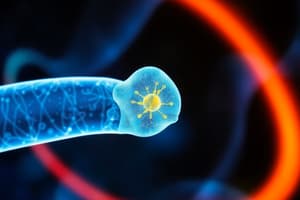Podcast
Questions and Answers
What is a critical function of feedback systems in maintaining homeostasis?
What is a critical function of feedback systems in maintaining homeostasis?
- They provide a way to completely eliminate stimuli.
- They solely rely on hormonal signals without nervous input.
- They enhance the intensity of stimuli.
- They cycle through phases of monitoring and correction. (correct)
Which of the following components is NOT part of a feedback system?
Which of the following components is NOT part of a feedback system?
- Control center
- Initiator (correct)
- Receptor
- Stimulus
How does negative feedback work in maintaining blood glucose levels?
How does negative feedback work in maintaining blood glucose levels?
- By increasing the glucose level when it rises too high.
- By consistently increasing metabolic rate.
- By stimulating insulin release to lower glucose levels. (correct)
- By ignoring changes to blood glucose entirely.
Which term refers to the total concentration of solute particles in a solution?
Which term refers to the total concentration of solute particles in a solution?
What role does the effector play in a feedback system?
What role does the effector play in a feedback system?
What causes disturbances to homeostasis within the human body?
What causes disturbances to homeostasis within the human body?
Which of the following is commonly monitored as a controlled condition?
Which of the following is commonly monitored as a controlled condition?
In the context of cellular homeostasis, what best describes the role of the nervous system?
In the context of cellular homeostasis, what best describes the role of the nervous system?
What role does the control center play in maintaining homeostasis?
What role does the control center play in maintaining homeostasis?
Which of the following correctly describes an effector's function?
Which of the following correctly describes an effector's function?
In a negative feedback system, what happens when there is an increase in a controlled condition?
In a negative feedback system, what happens when there is an increase in a controlled condition?
Which statement accurately reflects the feedback loop involving blood pressure regulation?
Which statement accurately reflects the feedback loop involving blood pressure regulation?
What is the primary output generated by the control center to regulate body temperature?
What is the primary output generated by the control center to regulate body temperature?
How does positive feedback differ from negative feedback in a biological system?
How does positive feedback differ from negative feedback in a biological system?
What triggers the body’s response in temperature regulation when exceeding the set point?
What triggers the body’s response in temperature regulation when exceeding the set point?
Which of these describes the function of baroreceptors in the control of blood pressure?
Which of these describes the function of baroreceptors in the control of blood pressure?
What happens to the controlled condition when the actions of the effector occur after input from the control center?
What happens to the controlled condition when the actions of the effector occur after input from the control center?
What describes the phenomenon where water moves to dilute a more concentrated solution?
What describes the phenomenon where water moves to dilute a more concentrated solution?
What is the relationship between osmolarity and osmolality?
What is the relationship between osmolarity and osmolality?
Which of the following methods can prevent water movement from a diluted to a concentrated solution?
Which of the following methods can prevent water movement from a diluted to a concentrated solution?
If a cell is placed in a hyperosmotic solution, what happens to its volume?
If a cell is placed in a hyperosmotic solution, what happens to its volume?
What term is used to describe the effect of a solution on cell volume when the cell reaches equilibrium?
What term is used to describe the effect of a solution on cell volume when the cell reaches equilibrium?
What action is taken by blood vessels when body temperature rises above 37.0 ∘C?
What action is taken by blood vessels when body temperature rises above 37.0 ∘C?
In a negative feedback system, which of the following describes the pathway from temperature detection to response?
In a negative feedback system, which of the following describes the pathway from temperature detection to response?
Which physiological response is associated with a decrease in body temperature?
Which physiological response is associated with a decrease in body temperature?
What characterizes a positive feedback system?
What characterizes a positive feedback system?
During which physiological process is positive feedback prominently observed?
During which physiological process is positive feedback prominently observed?
Which of the following is NOT a feature of negative feedback systems?
Which of the following is NOT a feature of negative feedback systems?
What is a potential risk of uncontrolled positive feedback?
What is a potential risk of uncontrolled positive feedback?
What role do sweat glands play in temperature regulation during increased body temperature?
What role do sweat glands play in temperature regulation during increased body temperature?
What happens to the blood vessels when body temperature drops below the set point?
What happens to the blood vessels when body temperature drops below the set point?
What initiates the physiological responses in both feedback systems?
What initiates the physiological responses in both feedback systems?
What is the primary function of the extracellular fluid (ECF)?
What is the primary function of the extracellular fluid (ECF)?
Which substance is primarily responsible for the osmotic activity in extracellular fluid?
Which substance is primarily responsible for the osmotic activity in extracellular fluid?
How does the composition of plasma differ from that of interstitial fluid?
How does the composition of plasma differ from that of interstitial fluid?
What occurs when there is a depletion of sodium (Na+) in the extracellular fluid?
What occurs when there is a depletion of sodium (Na+) in the extracellular fluid?
The primary anions in extracellular fluid are predominantly composed of which substances?
The primary anions in extracellular fluid are predominantly composed of which substances?
What is the significant contribution of the protein concentration gradient in plasma compared to interstitial fluid?
What is the significant contribution of the protein concentration gradient in plasma compared to interstitial fluid?
In what form do the negative charges predominantly exist in intracellular fluid (ICF)?
In what form do the negative charges predominantly exist in intracellular fluid (ICF)?
What is the relationship between extracellular fluid (ECF) and intracellular fluid (ICF) in terms of water flux?
What is the relationship between extracellular fluid (ECF) and intracellular fluid (ICF) in terms of water flux?
What is the main consequence of hypernatremia in regards to extracellular fluid volume?
What is the main consequence of hypernatremia in regards to extracellular fluid volume?
Flashcards are hidden until you start studying
Study Notes
Homeostasis
- Homeostasis is the state of maintaining a constant internal environment.
- The human body is constantly subjected to disruptions that alter the internal environment. These disruptions can be external, such as extreme heat, or internal, such as changes in blood glucose levels.
- The nervous and endocrine systems work together to regulate these disruptions and maintain homeostasis through negative feedback systems.
Feedback Systems
- A feedback system or feedback loop is a series of events that monitors, evaluates, changes, re-monitors, and re-evaluates the status of a body condition.
- The monitored variable is called the controlled condition.
- Any disruption that changes the controlled condition is called a stimulus.
- A feedback system consists of a receptor, a control center, and an effector.
- The receptor detects changes in the controlled condition and sends input to the control center through an afferent pathway.
- The control center sets the range of values for the controlled condition (set point), evaluates the input received from the receptors, and generates output commands through the efferent pathway.
- The effector receives the output from the control center and produces a response that changes the controlled condition.
Negative Feedback Systems
- A negative feedback system reverses a change in the controlled condition.
- They help maintain stability in the body.
- An example is the regulation of blood pressure.
- If blood pressure rises, baroreceptors detect the change and send signals to the brain.
- The brain then sends signals to the heart and blood vessels to decrease heart rate and dilate the blood vessels, lowering blood pressure.
Regulation of Body Temperature
- Body temperature is regulated by a negative feedback system.
- The set point for body temperature is 37°C.
- When body temperature rises above the set point, receptors in the skin and brain detect the change and send signals to the temperature regulatory center in the hypothalamus.
- The hypothalamus then signals effectors, such as sweat glands and blood vessels, to help cool the body down.
- When body temperature falls below the set point, the hypothalamus signals effectors, such as blood vessels and muscles, to help warm the body up.
Positive Feedback Systems
- A positive feedback system strengthens or reinforces a change in a controlled condition.
- The effector produces a response that adds to the initial change, continuing until an external event stops the system.
- Examples include normal childbirth and suckling reflex.
- Positive feedback systems can lead to unhealthy outcomes if they continue unchecked.
Body Fluid Composition
- The “internal environment” is the Extracellular Fluid (ECF), where cells live.
- ECF between cells is called interstitial fluid and contains substances essential for cell survival.
- ECF acts as a transition between the internal and external environments.
- Maintaining a constant ECF compartment is essential for homeostasis.
Differences in ICF and ECF
- The dominant cation in ECF is Na+ while in ICF it's K+.
- Cl- and HCO3- are the main anions in ECF, while phosphates and proteins are predominant in ICF.
- There is normally no net flux of water across the cell membrane, meaning ECF and ICF are in osmotic equilibrium.
Body Fluid Compartments
- The body fluid compartments include:
- Plasma (3 L)
- Interstitial fluid (12 L)
- Transcellular fluid (200-500 ml)
Osmolarity, Osmolality, Osmotic Pressure, and Tonicity
- Osmosis is the movement of water across a membrane in response to a solute concentration gradient.
- Osmotic pressure is the mechanical pressure needed to prevent water movement from a diluted side to a concentrated side due to the concentration of solutes.
- Osmolality is the concentration of osmotically active substances in a solution. Its units are osmoles per kilogram of water.
- Osmolarity is another term for osmotic concentration. Its units are osmoles per liter of solution.
- Tonicity is a physiological term that describes a solution's ability to affect cell volume when the cell is placed in the solution. It compares a solution to a cell.
Differences in Plasma and Interstitial Fluid
- Plasma contains a significant concentration of proteins, while interstitial fluid does not.
- This protein concentration gradient contributes to the balance of forces across the capillary wall.
Role of Sodium in ECF
- Na+ is the dominant cation in ECF and responsible for nearly all osmotic activity in ECF.
- Na+ depletion (hyponatremia) is linked to low ECF volume (hypovolemia), while Na+ retention (hypernatremia) is associated with ECF volume expansion (hypervolemia).
Studying That Suits You
Use AI to generate personalized quizzes and flashcards to suit your learning preferences.



